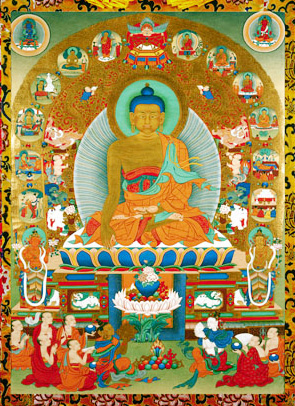Twelve deeds: Difference between revisions
Jump to navigation
Jump to search
mNo edit summary |
(→Notes) |
||
| Line 16: | Line 16: | ||
==Notes== | ==Notes== | ||
<small><references/></small> | <small><references/></small> | ||
==Teachings Given to the [[About Rigpa|Rigpa]] Sangha== | |||
*[[Dzogchen Rinpoche]], [[Lerab Ling]], 6-7 June 1998 | |||
==Further Reading== | ==Further Reading== | ||
Revision as of 14:41, 10 February 2012

The twelve deeds (Skt. dvadaśabuddhakārya; Wyl. mdzad pa bcu gnyis) carried out by a supreme nirmanakaya buddha, such as the Buddha Shakyamuni, are:
- the descent from Tushita, the Joyous pure land (dga' ldan gyi gnas nas 'pho ba),
- entering the mother’s womb (lhums su zhugs pa),
- taking birth[1] (sku bltams pa),
- becoming skilled in various arts (bzo yi gnas la mkhas pa),
- delighting in the company of royal consorts (btsun mo'i 'khor dgyes rol ba),
- developing renunciation and becoming ordained (rab tu byung ba),
- practicing austerities for six years (dka' ba spyad pa),
- proceeding to the foot of the bodhi tree (byang chub snying por gshegs pa),
- overcoming Mara’s hosts (bdud btul ba),
- becoming fully enlightened (mngon par rdzogs par sangs rgyas pa),
- turning the wheel of Dharma (chos kyi 'khor lo bskor ba), and
- passing into mahaparinirvana [2] (mya ngan las 'das pa)
Notes
- ↑ In the case of Buddha Shakyamuni, this was in the Lumbini garden.
- ↑ In the case of Buddha Shakyamuni, this was in the city of Kushinagara.
Teachings Given to the Rigpa Sangha
- Dzogchen Rinpoche, Lerab Ling, 6-7 June 1998
Further Reading
- Lobsang Dhargyay, 'The Twelve Deeds of the Buddha—A Controversial Hymn ascribed to Nagarjuna' in The Tibet Journal, Vol.IX, No.2, Summer 1984